- Prelude
- Editorial
- Manjit Bawa
- Husain's Calcutta
- Vivan's Visionary Reconstruction of History at Victoria Memorial, 1998
- The Remaking of Indian Painting
- Picasso Re-visited
- Benodebehari Mukherjee: A Recluse and the Centenary Show
- In Past and Present Continuum Speaking to Thota Vaikuntam
- The Importance of Being Husain
- Image-making to Image-circulation: Implicated Image(ry)
- 153 Years Old yet Young at Heart: Mumbai's Sir JJ School of Art
- Two Decades: A Critical Insight by an Art Critic and an Artist
- Biedermeier Style: Biedermeier Furniture
- Vacheron Constantin
- The Irony of Andy Warhol
- Then and Now: An Indian Perspective to the Art Market 1990-2010
- Pablo, Andy, Here I Come
- What Happened and What's Forthcoming
- Bid's Got Hammered?
- Anish Kapoor at National Gallery of Modern Art in Delhi and Mehboob Studio in Mumbai
- Tribute to Hemanta Misra: the “Calcutta Group” Painter
- Art Events Kolkata
- Mumbai Art Sighting
- Art Bengaluru
- Exploring the Riverine Culture of Bengal
- Alternative art practices define Bangalore
- India Art Summit Turns Three
- An Aesthetic Fair
- SSVAD: A New Arts Centre in Santineketan
- Visible Invisible by Siraj Saxena
- A Fleeting World : Paintings by Sunil De
- Previews
- In the News
ART news & views
Bid's Got Hammered?
Volume: 3 Issue No: 12 Month: 1 Year: 2011
Through the Looking Glass
by Shoma Bhattacharjee & Rumi Banerjee
Paintings offered at Bid & Hammer's November auction left a thick trail of shady ladies, some hard talking, and a court order….but few takers
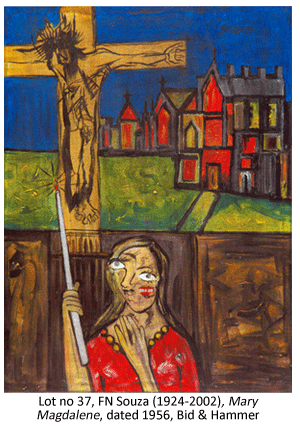 Imitation, they said, is the best form of flattery but the cliché feels like yesterday's news when imitation also becomes a tool of deception. People start wondering and the buzz vaporizes into blue fury, even censure, when those being imitated are not around to defend their name. At a time when the personal right to information is hogging all the headlines, it is all the more reason to keep the hum alive, give it a broader pitch. Raise a few questions, maybe. Share a bit of information.
Imitation, they said, is the best form of flattery but the cliché feels like yesterday's news when imitation also becomes a tool of deception. People start wondering and the buzz vaporizes into blue fury, even censure, when those being imitated are not around to defend their name. At a time when the personal right to information is hogging all the headlines, it is all the more reason to keep the hum alive, give it a broader pitch. Raise a few questions, maybe. Share a bit of information.
An auction sale, organized by the Bangalore-based Bid & Hammer Fine Art Auctioneers, titled Significant Indian Paintings would have just come and gone like any other unremarkable event. It was supposed to go live on November 30, 2010.  However, the aptly named Sale 007 seems to have an aura of mystery,much like it's undercover namesake. At the time of going to print, a notice on the auctioneer's homepage reads thus: 'Due to technical reasons,Sale 0007 is being rescheduled. We appreciate your continued support. Bid & Hammer Team.'
However, the aptly named Sale 007 seems to have an aura of mystery,much like it's undercover namesake. At the time of going to print, a notice on the auctioneer's homepage reads thus: 'Due to technical reasons,Sale 0007 is being rescheduled. We appreciate your continued support. Bid & Hammer Team.'
To go back to the unholy beginnings ….Did Mary Magdalene among others lead to this change of plans? Lot 37, titled Mary Magdalene, and attributed to F N Souza, was one of the paintings that figured prominently in the auction's suite. The figure in the foreground of the painting, presumably Mary's, (dated 1956, as per the provenance), bears a coarse resemblance to the cubist-inspired Suruchi in Portrait of Suruchi Chand, painted in 1984. Mary also has a cross and alarge mansion ('inspired by' another Souza masterpiece, Manor House) in the background, again both crudely executed.
Suruchi…But In Bad Taste
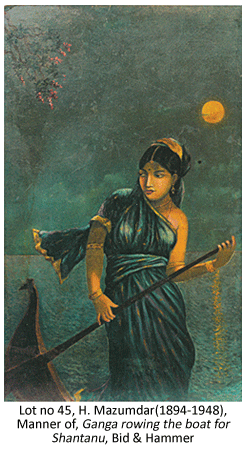 “It is clearly a badly-rendered fake. This is not an original by Souza.” Strong words, from a close associate of the late Francis Newton Souza, Srimati Lal, about Mary Magdalene. She adds: “Any informed Souza viewer can see from the bad drawing and terrible colour palette of this work that it's a fake. Someone has imitated the '84 Portrait of Suruchi Chand here and placed it as a depiction of Magdalene.”
“It is clearly a badly-rendered fake. This is not an original by Souza.” Strong words, from a close associate of the late Francis Newton Souza, Srimati Lal, about Mary Magdalene. She adds: “Any informed Souza viewer can see from the bad drawing and terrible colour palette of this work that it's a fake. Someone has imitated the '84 Portrait of Suruchi Chand here and placed it as a depiction of Magdalene.”
So what's new, one may say. There have been and will be fakes, scams and flat denials in civil society and the art circuit is but a microcosm of the former. However, when an organization which calls itself “a full-fledged auction house” with a team of experts to advise “on the historical, social, political and economic context of a work of art” showcases a painting which evokes such reactions, even a jaded veteran may do a double take. More so, when the better part of the print media chooses to walk the chalta hai path.
For the record, Souza met Chand only in 1982 and did a sketch of her in the same year, but painted the likeness only in 1984. So, if one was to go by Bid & Hammer's claims, the 1956 Mary Magdalene would be a disastrous prequel to the 1984 Suruchi. Portrait of Suruchi Chand fetched Rs 18.4 lakh at the Saffronart auction in 2009. 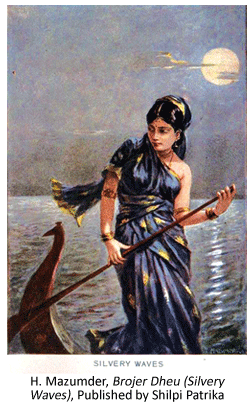 According to Souza little hand-written note on the back of this painting, Suruchi Chand was the only woman he met who had stayed with Picasso in the south of France.
According to Souza little hand-written note on the back of this painting, Suruchi Chand was the only woman he met who had stayed with Picasso in the south of France.
Souza narrated his deep-impact encounter with Suruchi in a dairy entry: “It happened one evening on March 18, 1982, at the Lalit Kala Academy, New Delhi, where a seminar was underway”. He wrote: “I will have to collect my thoughts because her intoxicating perfume is still in my head and intoxication makes a scatterbrain, and a scatterbrain cannot recollect the sequences in order. (He added afterwards in the margin, marking the addition with an asterisk at this point in his writing) She's like swallowing a glass of brandy: the bouquet hit me first and then her spirited conversation began working on me. (His journal entry continues) I will write at length about this girl, woman, lady, goddess this intellectual and artist, this lovely wholesome gorgeous broad. She's excited me; a rare peak. Suruchi has a retinue of men hanging round her on the reak (sic) of her scented pheromones." This is up for public viewing in the website of Souza's estate (http://fnsouza.info/paintings/paintings_028.html).
Comedy of 'Manner'
As if to add to the dare, the auction house decided to put up another painting (Lot 45), which it openly acknowledged as a 'work done in the manner of Hemendranath Mazumder'.  Yet, contradicting that statement, the text in the catalogue concludes that the several 'trademark' features 'pointedly suggest it to be a work of Hemendranath Mazumder'. Now, even someone with a passing knowledge of English would figure out that 'in the manner of' would not translate as 'an original'. So, in this case, Manner of Ganga Rowing the Boat for Shantanu, was put up for auction with a written admission by the auctioneer that it was both a reproduction and an original all at the same time!
Yet, contradicting that statement, the text in the catalogue concludes that the several 'trademark' features 'pointedly suggest it to be a work of Hemendranath Mazumder'. Now, even someone with a passing knowledge of English would figure out that 'in the manner of' would not translate as 'an original'. So, in this case, Manner of Ganga Rowing the Boat for Shantanu, was put up for auction with a written admission by the auctioneer that it was both a reproduction and an original all at the same time!
To the trained eye, the telltale giveaways are more than obvious. “Hemendranath Mazumder was incapable of such non-anatomical drawing of hands,” says art historian Pranab Ranjan Ray about Lot 45. Artist and authenticator Samindranath Majumdar corroborates: “Besides the blatant quality differential, the phrase,'in the manner of' would translate as 'in the style of'.Of course there is no law to stop anyone from executing (or selling) an art work in the style of another person. However, doubts are bound to be raised if the painting that is supposed to be in the manner of is an obvious copy of the original. Such is the case with Ganga Rowing, which looks like a failed attempt at replicating Mazumder's Brojer Dheu, also titled Silvery Waves published in Mashik Basumati in the year 1929(according to Bengali calendar year1336).”
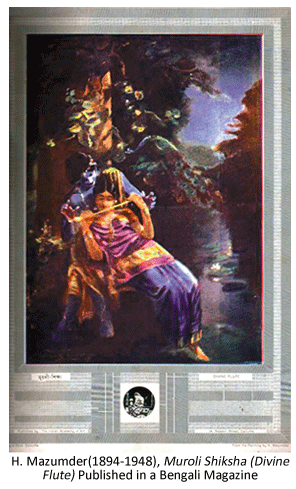 A second painting attributed to Mazumder (this time not even by way of 'in the manner') called Radha Learning to Play the Flute from Krishna (Lot 28), also raises eyebrows, if only for the copier's ineptitude at replicating Muroli Shikkha, a painting done by the late Mazumder in 1917. “Muroli Shikkha depicts Krishna sitting cross-legged while Radha Learning shows Krishna sitting with his legs apart.” points out Samindranath, grandson of H Mazumder. An image of Muroli Shikkha was reproduced in a folio, Art of H Mazumder which was published by The Indian Academy of Art from 24 Beadon Street, Calcutta. This academy was helmed by Mazumder himself.”In 1917, Mazumder had honed his highlighting skills to near perfection, though he may not have been all that proficient in the detailing of ornaments. In Radha Learning, the highlights are amateurish, the lines that define Radha and Krishna rigid. All said and done, the least one would expect from a skilled draughtsman like Mazumder would be proportionate figures. That too is missing here. If one were to consider Radha Learning as a 'variation'just for the sake of argument,the slipshod draughtsmanship would burn holes in that hypothesis.”
A second painting attributed to Mazumder (this time not even by way of 'in the manner') called Radha Learning to Play the Flute from Krishna (Lot 28), also raises eyebrows, if only for the copier's ineptitude at replicating Muroli Shikkha, a painting done by the late Mazumder in 1917. “Muroli Shikkha depicts Krishna sitting cross-legged while Radha Learning shows Krishna sitting with his legs apart.” points out Samindranath, grandson of H Mazumder. An image of Muroli Shikkha was reproduced in a folio, Art of H Mazumder which was published by The Indian Academy of Art from 24 Beadon Street, Calcutta. This academy was helmed by Mazumder himself.”In 1917, Mazumder had honed his highlighting skills to near perfection, though he may not have been all that proficient in the detailing of ornaments. In Radha Learning, the highlights are amateurish, the lines that define Radha and Krishna rigid. All said and done, the least one would expect from a skilled draughtsman like Mazumder would be proportionate figures. That too is missing here. If one were to consider Radha Learning as a 'variation'just for the sake of argument,the slipshod draughtsmanship would burn holes in that hypothesis.”
Ray leaves no room for doubt. “Hemen Mazumder was a much better draughtsman than the waist-below part of the woman shows him to be. Besides, the overall drawing is poor whereas Mazumder's perspectives were much better worked out,” he says. In fact, Ray does not have to look too far and deep for more suspect material as dubious Bengal School lots crop up like a promiscuous virus in Bid & Hammer's innovative suite.
The Eyes Don't Match
 About Lot 23, alleged to be a Rabindranath Tagore work, Ray has this to say: “The untrained painter (Tagore) did not know the rules of chiaroscuro but this painting is by someone who knew it but posed as someone who did not know.” Lot 24 is an eye-opener of sorts. “In Rabindranath's paintings 'open eyes' are always brightly made. In this, the eye on the far side is in darkness. The contour line of the face always stands out from the background, here it gets merged with the shoulder line, neck line, and the hair behind. This is unlikely.”
About Lot 23, alleged to be a Rabindranath Tagore work, Ray has this to say: “The untrained painter (Tagore) did not know the rules of chiaroscuro but this painting is by someone who knew it but posed as someone who did not know.” Lot 24 is an eye-opener of sorts. “In Rabindranath's paintings 'open eyes' are always brightly made. In this, the eye on the far side is in darkness. The contour line of the face always stands out from the background, here it gets merged with the shoulder line, neck line, and the hair behind. This is unlikely.”
About Lot 25, this time a 'Jamini Roy', he says: “The eyes of the woman are clearly like those in his Santhal Woman series with a central pupil. However, the colour scheme does not go with the other paintings of the series.” On Lot 40, attributed to Abanindranath Tagore: “Abanindranath was such a master of 'wash' that he would never have thought of placing a line after the final wash, which is evident in this painting.” 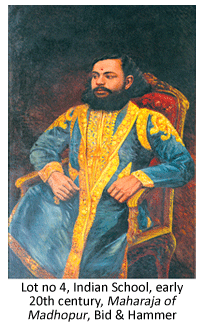 Even a skim-through of Lot 48, passed of as a Chittaprasad Bhattacharya masterpiece, leaves Ray baffled. “When did Chittaprasad apply colours in 'tonal gradations with massy lines,' to quote from the catalogue?” he wonders.
Even a skim-through of Lot 48, passed of as a Chittaprasad Bhattacharya masterpiece, leaves Ray baffled. “When did Chittaprasad apply colours in 'tonal gradations with massy lines,' to quote from the catalogue?” he wonders.
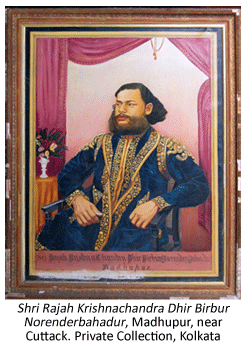 And wonders never cease. Lot 4, a painting called the Maharaja of Madhopur, is displayed on the homepage of Bid & Hammer. The provenance reads: 'Originally from the collection of a zamindar family of Bihar. Acquired in mid-1970s by a Kolkata-based collector.' However, the Maharaja of 'Madhopur' bears a mysterious likeness to the Maharaja of Madhupur (not Madhopur), as he appears in the painting in the archives of the 'Kolkata-based collector', muddying the landscape a bit more. The original Maharaja of Madhupur, reproduced here, carries the following script below the portrait: Shri Rajah Krishnachandra Dhir Birbur Norenderbahadur Madhupur (Near Katak) (Private Collection). For the record, it was acquired sometime in the mid-1990s from the aristocrats of Madhupur, near Cuttack in Orissa by the Kolkata collector.
And wonders never cease. Lot 4, a painting called the Maharaja of Madhopur, is displayed on the homepage of Bid & Hammer. The provenance reads: 'Originally from the collection of a zamindar family of Bihar. Acquired in mid-1970s by a Kolkata-based collector.' However, the Maharaja of 'Madhopur' bears a mysterious likeness to the Maharaja of Madhupur (not Madhopur), as he appears in the painting in the archives of the 'Kolkata-based collector', muddying the landscape a bit more. The original Maharaja of Madhupur, reproduced here, carries the following script below the portrait: Shri Rajah Krishnachandra Dhir Birbur Norenderbahadur Madhupur (Near Katak) (Private Collection). For the record, it was acquired sometime in the mid-1990s from the aristocrats of Madhupur, near Cuttack in Orissa by the Kolkata collector.
Court Hammers The Final Nail
In response to a petition filed by Archana Narayanan a great grandniece of Raja Ravi Varma, the division court of Kerala High Court ordered on November 29, 2010, that a painting by Raja Ravi Varma, being put up at an auction by Bid & Hammer, if sold, should not be exported or its possession transferred within a month. The bench clarified that the sale would be subject to the result of the petition.
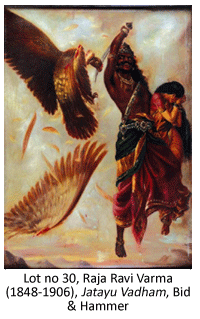
The court also directed the auction house to file a statement regarding ownership and justifying the sale of the paintings.
Herself a lawyer, Archana Narayanan, said she came to know about the auction from the website of the Bid & Hammer. The Hindu reported: “She said there were two paintings titled Jadayu Vadham. One of them was exhibited at the Sri Jayachamarajendra Art Gallery, Mysore. The other one was handed over to the state government. However, no such painting was displayed at the state-owned Sree Chitra Art Gallery, Thiruvananthapuram. She said it could be assumed that the auctioneer received the painting from somebody who had smuggled it out.
It is true that with works of art that originated in a different age, an age of innocence, a more cavalier, trusting age, when authentication certificates were not mandatory, the job of proving provenance is challenging. However, it's best not to laugh away the challenge as a loophole. It's best to quickly accept that we are living in an age of social networking, of sharing information. Of wikileaks!